steering FIAT DUCATO 2011 Owner handbook (in English)
[x] Cancel search | Manufacturer: FIAT, Model Year: 2011, Model line: DUCATO, Model: FIAT DUCATO 2011Pages: 287, PDF Size: 4.42 MB
Page 7 of 287
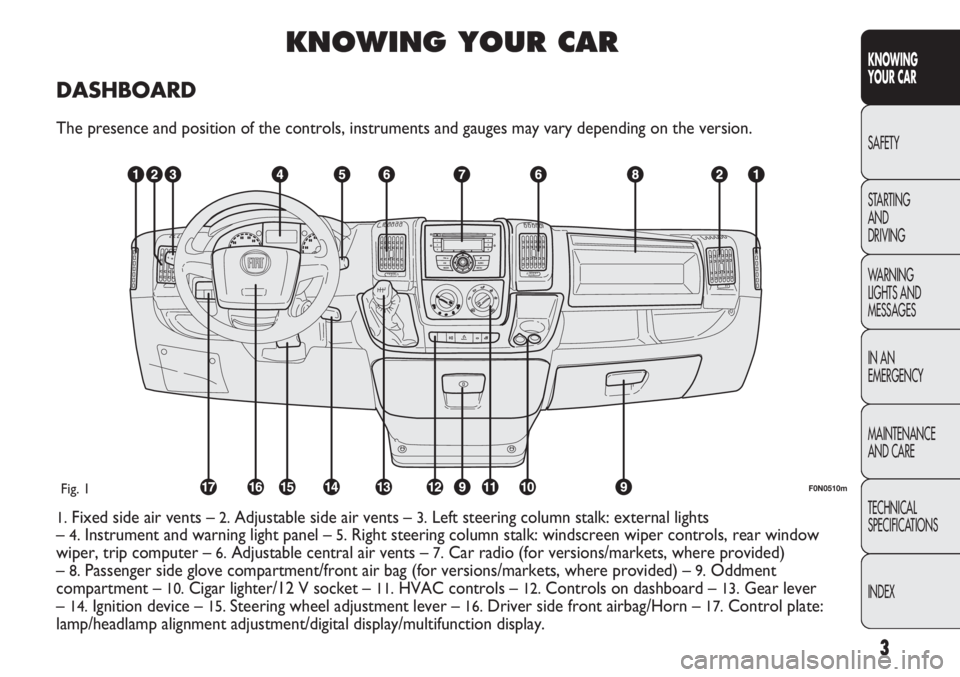
3
KNOWING
YOUR CAR
SAFETY
STARTING
AND
DRIVING
WARNING
LIGHTS AND
MESSAGES
IN AN
EMERGENCY
MAINTENANCE
AND CARE
TECHNICAL
SPECIFICATIONS
INDEX
KNOWING YOUR CAR
DASHBOARD
The presence and position of the controls, instruments and gauges may vary depending on the version.
1.Fixed side air vents –2.Adjustable side air vents – 3.Left steering column stalk: external lights
–
4.Instrument and warning light panel – 5.Right steering column stalk: windscreen wiper controls, rear window
wiper, trip computer –
6.Adjustable central air vents – 7.Car radio (for versions/markets, where provided)
–
8.Passenger side glove compartment/front air bag (for versions/markets, where provided) – 9.Oddment
compartment –
10.Cigar lighter/12 V socket – 11.HVAC controls – 12.Controls on dashboard – 13.Gear lever
–
14.Ignition device – 15. Steering wheel adjustment lever – 16.Driver side front airbag/Horn – 17.Control plate:
lamp/headlamp alignment adjustment/digital display/multifunction display.
F0N0510mFig. 1
Page 16 of 287
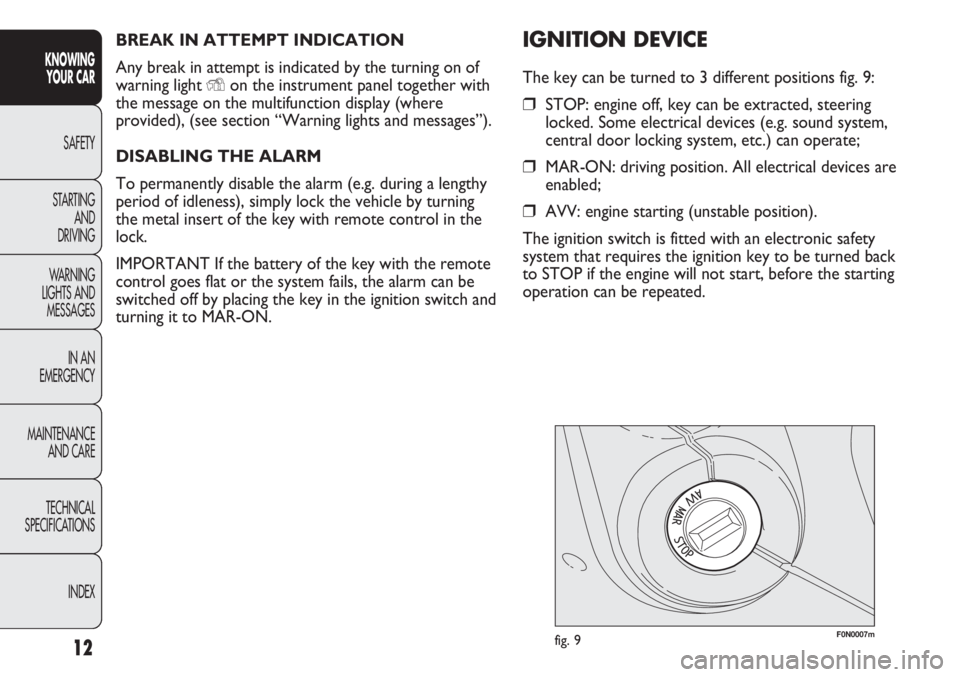
BREAK IN ATTEMPT INDICATION
Any break in attempt is indicated by the turning on of
warning light
Yon the instrument panel together with
the message on the multifunction display (where
provided), (see section “Warning lights and messages”).
DISABLING THE ALARM
To permanently disable the alarm (e.g. during a lengthy
period of idleness), simply lock the vehicle by turning
the metal insert of the key with remote control in the
lock.
IMPORTANT If the battery of the key with the remote
control goes flat or the system fails, the alarm can be
switched off by placing the key in the ignition switch and
turning it to MAR-ON.
12
KNOWING
YOUR CAR
SAFETY
STARTING
AND
DRIVING
WARNING
LIGHTS AND
MESSAGES
IN AN
EMERGENCY
MAINTENANCE
AND CARE
TECHNICAL
SPECIFICATIONS
INDEX
IGNITION DEVICE
The key can be turned to 3 different positions fig. 9:
❒STOP: engine off, key can be extracted, steering
locked. Some electrical devices (e.g. sound system,
central door locking system, etc.) can operate;
❒MAR-ON: driving position. All electrical devices are
enabled;
❒AVV: engine starting (unstable position).
The ignition switch is fitted with an electronic safety
system that requires the ignition key to be turned back
to STOP if the engine will not start, before the starting
operation can be repeated.
F0N0007mfig. 9
Page 17 of 287
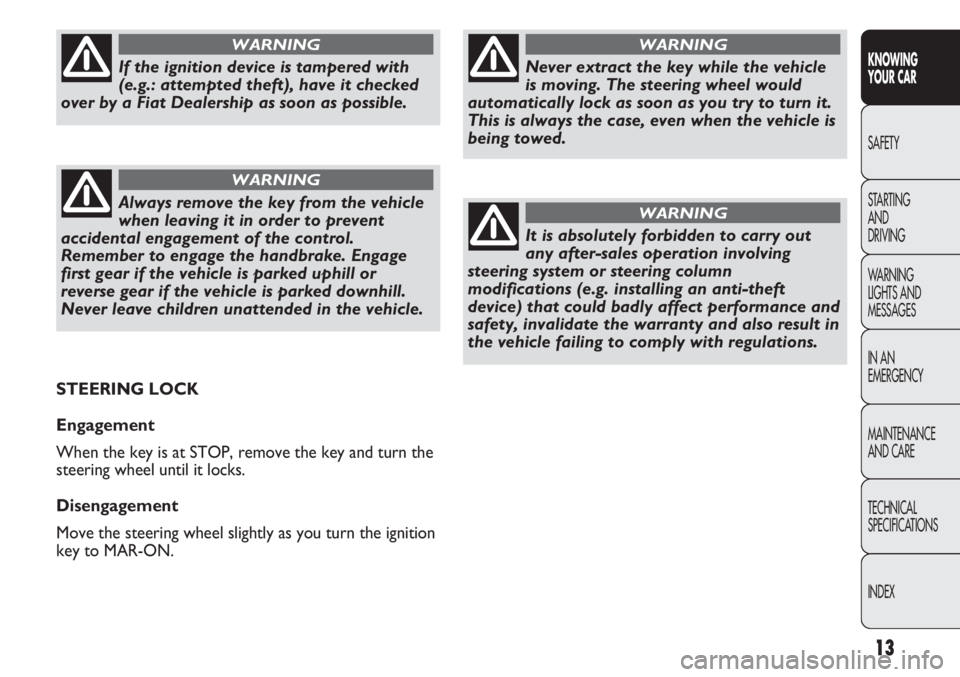
13
KNOWING
YOUR CAR
SAFETY
STARTING
AND
DRIVING
WARNING
LIGHTS AND
MESSAGES
IN AN
EMERGENCY
MAINTENANCE
AND CARE
TECHNICAL
SPECIFICATIONS
INDEX
Never extract the key while the vehicle
is moving. The steering wheel would
automatically lock as soon as you try to turn it.
This is always the case, even when the vehicle is
being towed.
WARNING
It is absolutely forbidden to carry out
any after-sales operation involving
steering system or steering column
modifications (e.g. installing an anti-theft
device) that could badly affect performance and
safety, invalidate the warranty and also result in
the vehicle failing to comply with regulations.
WARNING
If the ignition device is tampered with
(e.g.: attempted theft), have it checked
over by a Fiat Dealership as soon as possible.
WARNING
Always remove the key from the vehicle
when leaving it in order to prevent
accidental engagement of the control.
Remember to engage the handbrake. Engage
first gear if the vehicle is parked uphill or
reverse gear if the vehicle is parked downhill.
Never leave children unattended in the vehicle.
WARNING
STEERING LOCK
Engagement
When the key is at STOP, remove the key and turn the
steering wheel until it locks.
Disengagement
Move the steering wheel slightly as you turn the ignition
key to MAR-ON.
Page 35 of 287
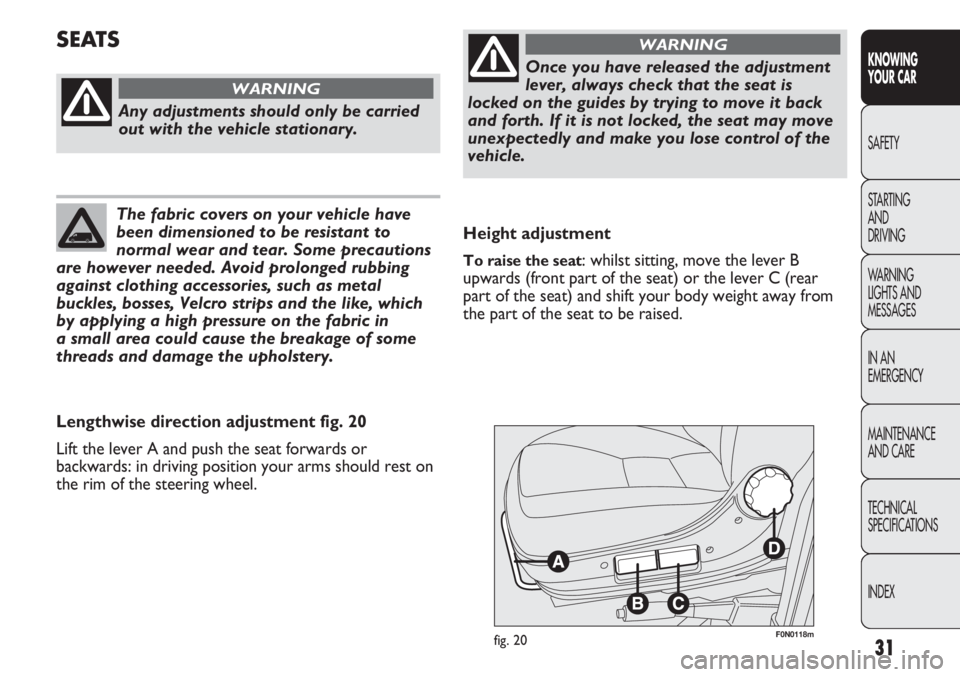
31
KNOWING
YOUR CAR
SAFETY
STARTING
AND
DRIVING
WARNING
LIGHTS AND
MESSAGES
IN AN
EMERGENCY
MAINTENANCE
AND CARE
TECHNICAL
SPECIFICATIONS
INDEX
F0N0118mfig. 20
Height adjustment
To raise the seat: whilst sitting, move the lever B
upwards (front part of the seat) or the lever C (rear
part of the seat) and shift your body weight away from
the part of the seat to be raised.
SEATS
Any adjustments should only be carried
out with the vehicle stationary.
WARNING
The fabric covers on your vehicle have
been dimensioned to be resistant to
normal wear and tear. Some precautions
are however needed. Avoid prolonged rubbing
against clothing accessories, such as metal
buckles, bosses, Velcro strips and the like, which
by applying a high pressure on the fabric in
a small area could cause the breakage of some
threads and damage the upholstery.
Lengthwise direction adjustment fig. 20
Lift the lever A and push the seat forwards or
backwards: in driving position your arms should rest on
the rim of the steering wheel.
Once you have released the adjustment
lever, always check that the seat is
locked on the guides by trying to move it back
and forth. If it is not locked, the seat may move
unexpectedly and make you lose control of the
vehicle.
WARNING
Page 45 of 287
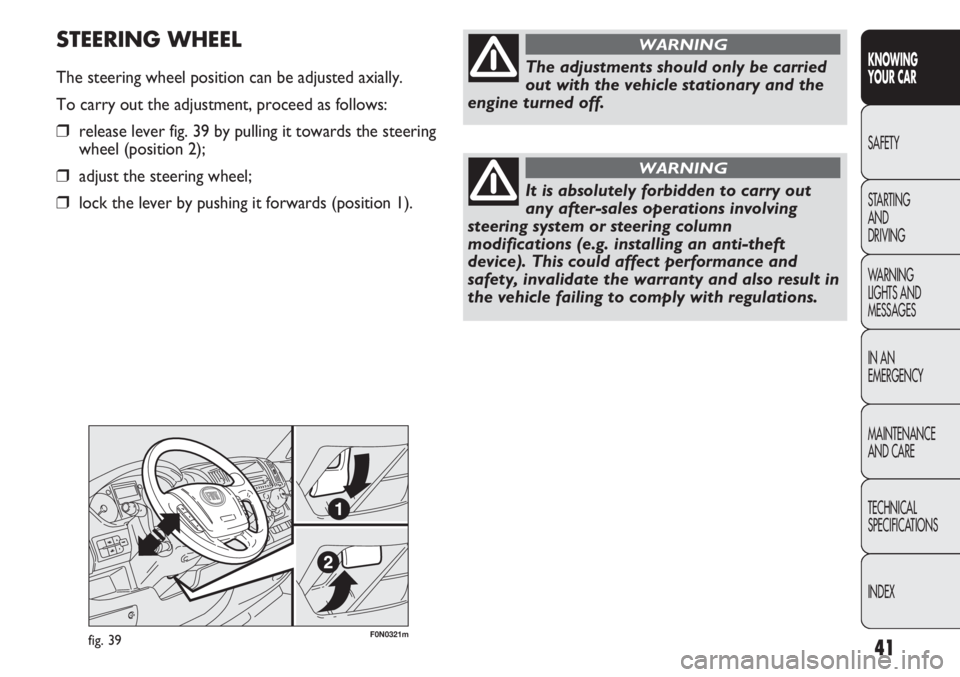
41
KNOWING
YOUR CAR
SAFETY
STARTING
AND
DRIVING
WARNING
LIGHTS AND
MESSAGES
IN AN
EMERGENCY
MAINTENANCE
AND CARE
TECHNICAL
SPECIFICATIONS
INDEX
F0N0321mfig. 39
STEERING WHEEL
The steering wheel position can be adjusted axially.
To carry out the adjustment, proceed as follows:
❒release lever fig. 39 by pulling it towards the steering
wheel (position 2);
❒adjust the steering wheel;
❒lock the lever by pushing it forwards (position 1).
The adjustments should only be carried
out with the vehicle stationary and the
engine turned off.
WARNING
It is absolutely forbidden to carry out
any after-sales operations involving
steering system or steering column
modifications (e.g. installing an anti-theft
device). This could affect performance and
safety, invalidate the warranty and also result in
the vehicle failing to comply with regulations.
WARNING
Page 73 of 287
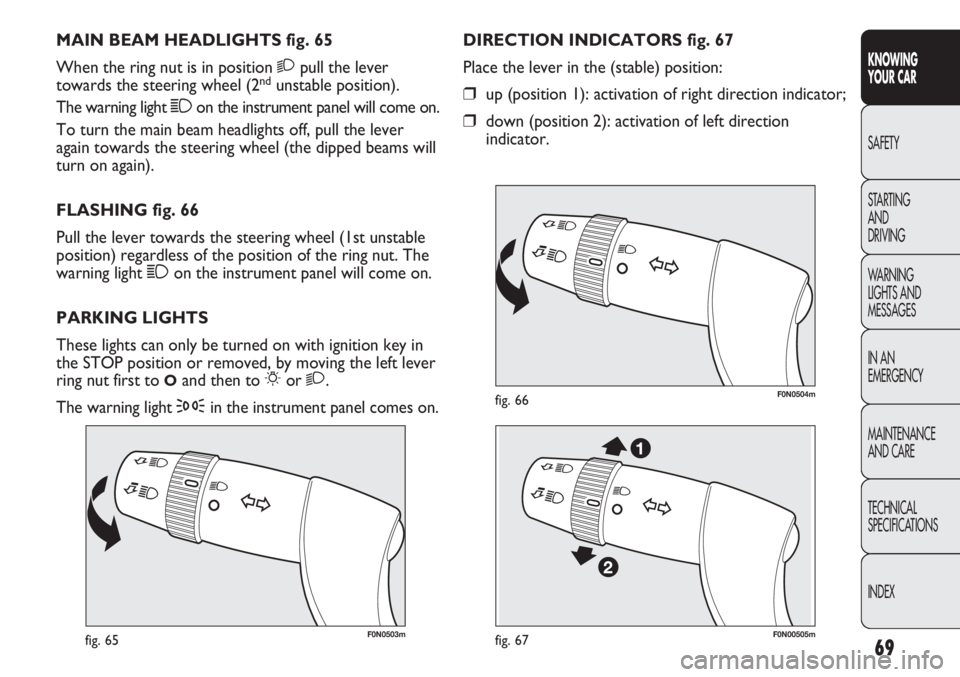
69
KNOWING
YOUR CAR
SAFETY
STARTING
AND
DRIVING
WARNING
LIGHTS AND
MESSAGES
IN AN
EMERGENCY
MAINTENANCE
AND CARE
TECHNICAL
SPECIFICATIONS
INDEX
F0N0503mfig. 65
F0N0504mfig. 66
DIRECTION INDICATORS fig. 67
Place the lever in the (stable) position:
❒up (position 1): activation of right direction indicator;
❒down (position 2): activation of left direction
indicator. MAIN BEAM HEADLIGHTS fig. 65
When the ring nut is in position 2pull the lever
towards the steering wheel (2
ndunstable position).
The warning light 1on the instrument panel will come on.
To turn the main beam headlights off, pull the lever
again towards the steering wheel (the dipped beams will
turn on again).
FLASHING fig. 66
Pull the lever towards the steering wheel (1st unstable
position) regardless of the position of the ring nut. The
warning light 1on the instrument panel will come on.
PARKING LIGHTS
These lights can only be turned on with ignition key in
the STOP position or removed, by moving the left lever
ring nut first to
Oand then to 6or 2.
The warning light
3in the instrument panel comes on.
F0N00505mfig. 67
Page 74 of 287
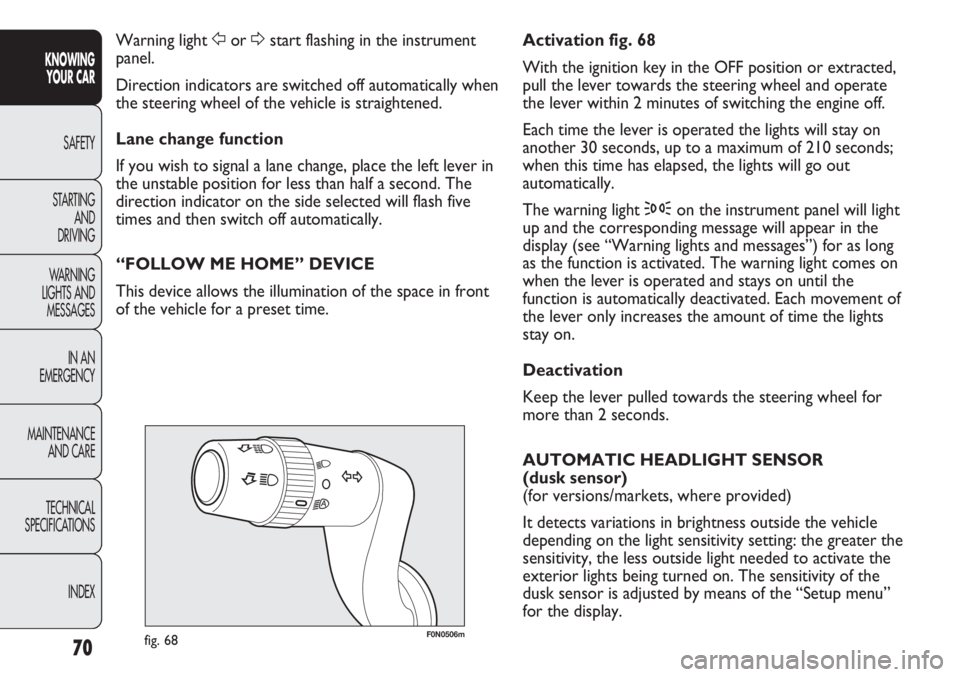
70
KNOWING
YOUR CAR
SAFETY
STARTING
AND
DRIVING
WARNING
LIGHTS AND
MESSAGES
IN AN
EMERGENCY
MAINTENANCE
AND CARE
TECHNICAL
SPECIFICATIONS
INDEX
F0N0506mfig. 68
Activation fig. 68
With the ignition key in the OFF position or extracted,
pull the lever towards the steering wheel and operate
the lever within 2 minutes of switching the engine off.
Each time the lever is operated the lights will stay on
another 30 seconds, up to a maximum of 210 seconds;
when this time has elapsed, the lights will go out
automatically.
The warning light 3on the instrument panel will light
up and the corresponding message will appear in the
display (see “Warning lights and messages”) for as long
as the function is activated. The warning light comes on
when the lever is operated and stays on until the
function is automatically deactivated. Each movement of
the lever only increases the amount of time the lights
stay on.
Deactivation
Keep the lever pulled towards the steering wheel for
more than 2 seconds.
AUTOMATIC HEADLIGHT SENSOR
(dusk sensor)
(for versions/markets, where provided)
It detects variations in brightness outside the vehicle
depending on the light sensitivity setting: the greater the
sensitivity, the less outside light needed to activate the
exterior lights being turned on. The sensitivity of the
dusk sensor is adjusted by means of the “Setup menu”
for the display. Warning light For Dstart flashing in the instrument
panel.
Direction indicators are switched off automatically when
the steering wheel of the vehicle is straightened.
Lane change function
If you wish to signal a lane change, place the left lever in
the unstable position for less than half a second. The
direction indicator on the side selected will flash five
times and then switch off automatically.
“FOLLOW ME HOME” DEVICE
This device allows the illumination of the space in front
of the vehicle for a preset time.
Page 76 of 287
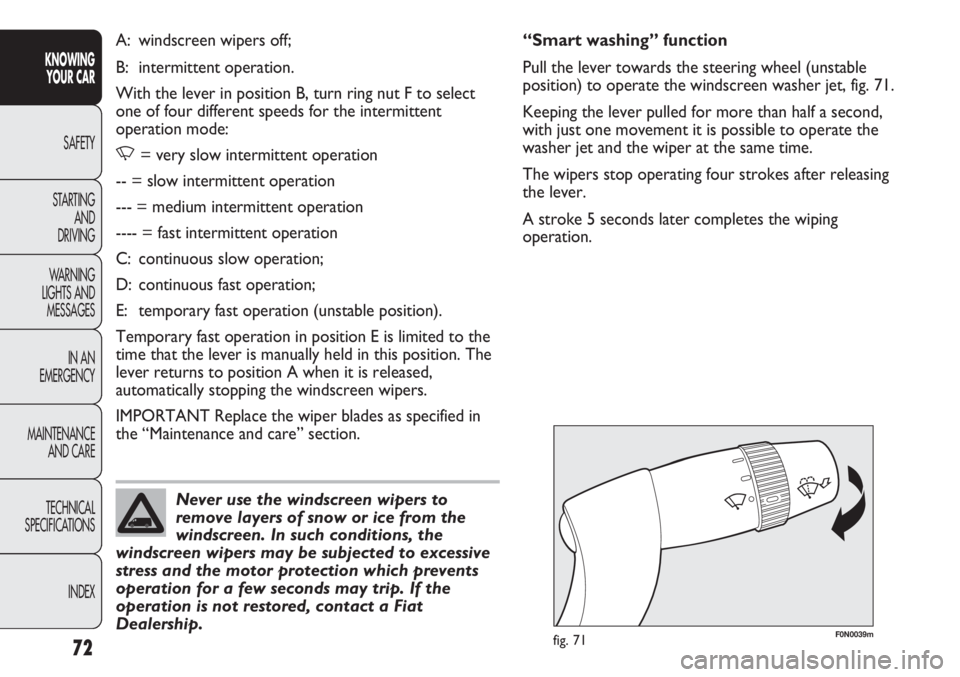
72
KNOWING
YOUR CAR
SAFETY
STARTING
AND
DRIVING
WARNING
LIGHTS AND
MESSAGES
IN AN
EMERGENCY
MAINTENANCE
AND CARE
TECHNICAL
SPECIFICATIONS
INDEX
F0N0039mfig. 71
“Smart washing” function
Pull the lever towards the steering wheel (unstable
position) to operate the windscreen washer jet, fig. 71.
Keeping the lever pulled for more than half a second,
with just one movement it is possible to operate the
washer jet and the wiper at the same time.
The wipers stop operating four strokes after releasing
the lever.
A stroke 5 seconds later completes the wiping
operation. A: windscreen wipers off;
B: intermittent operation.
With the lever in position B, turn ring nut F to select
one of four different speeds for the intermittent
operation mode:
,= very slow intermittent operation
-- = slow intermittent operation
--- = medium intermittent operation
---- = fast intermittent operation
C: continuous slow operation;
D: continuous fast operation;
E: temporary fast operation (unstable position).
Temporary fast operation in position E is limited to the
time that the lever is manually held in this position. The
lever returns to position A when it is released,
automatically stopping the windscreen wipers.
IMPORTANT Replace the wiper blades as specified in
the “Maintenance and care” section.
Never use the windscreen wipers to
remove layers of snow or ice from the
windscreen. In such conditions, the
windscreen wipers may be subjected to excessive
stress and the motor protection which prevents
operation for a few seconds may trip. If the
operation is not restored, contact a Fiat
Dealership.
Page 141 of 287
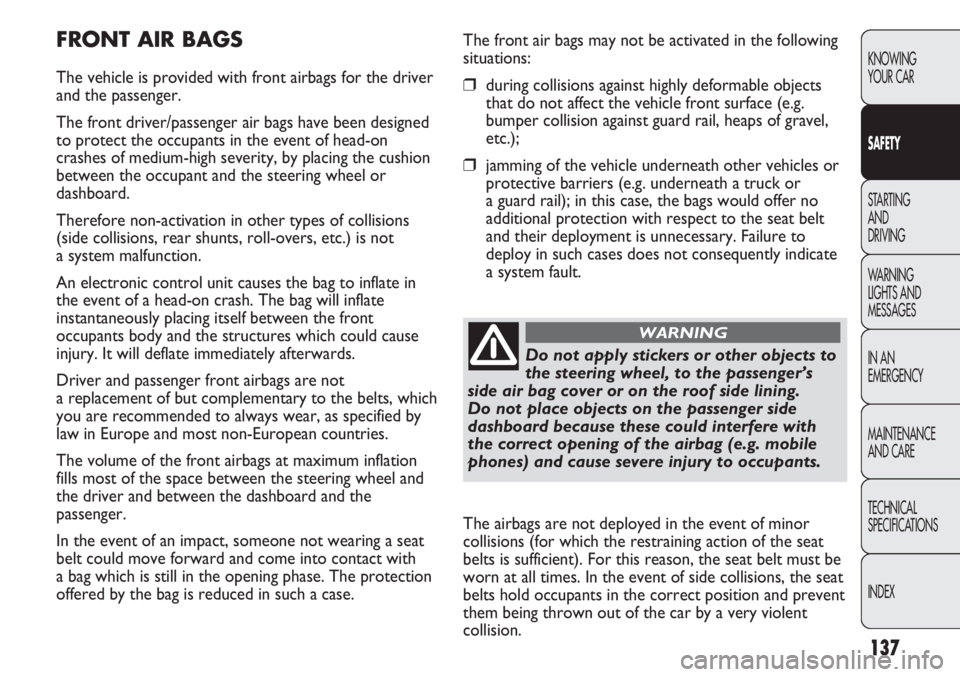
137
KNOWING
YOUR CAR
SAFETY
STARTING
AND
DRIVING
WARNING
LIGHTS AND
MESSAGES
IN AN
EMERGENCY
MAINTENANCE
AND CARE
TECHNICAL
SPECIFICATIONS
INDEX
The front air bags may not be activated in the following
situations:
❒during collisions against highly deformable objects
that do not affect the vehicle front surface (e.g.
bumper collision against guard rail, heaps of gravel,
etc.);
❒jamming of the vehicle underneath other vehicles or
protective barriers (e.g. underneath a truck or
a guard rail); in this case, the bags would offer no
additional protection with respect to the seat belt
and their deployment is unnecessary. Failure to
deploy in such cases does not consequently indicate
a system fault.
FRONT AIR BAGS
The vehicle is provided with front airbags for the driver
and the passenger.
The front driver/passenger air bags have been designed
to protect the occupants in the event of head-on
crashes of medium-high severity, by placing the cushion
between the occupant and the steering wheel or
dashboard.
Therefore non-activation in other types of collisions
(side collisions, rear shunts, roll-overs, etc.) is not
a system malfunction.
An electronic control unit causes the bag to inflate in
the event of a head-on crash. The bag will inflate
instantaneously placing itself between the front
occupants body and the structures which could cause
injury. It will deflate immediately afterwards.
Driver and passenger front airbags are not
a replacement of but complementary to the belts, which
you are recommended to always wear, as specified by
law in Europe and most non-European countries.
The volume of the front airbags at maximum inflation
fills most of the space between the steering wheel and
the driver and between the dashboard and the
passenger.
In the event of an impact, someone not wearing a seat
belt could move forward and come into contact with
a bag which is still in the opening phase. The protection
offered by the bag is reduced in such a case.
Do not apply stickers or other objects to
the steering wheel, to the passenger’s
side air bag cover or on the roof side lining.
Do not place objects on the passenger side
dashboard because these could interfere with
the correct opening of the airbag (e.g. mobile
phones) and cause severe injury to occupants.
WARNING
The airbags are not deployed in the event of minor
collisions (for which the restraining action of the seat
belts is sufficient). For this reason, the seat belt must be
worn at all times. In the event of side collisions, the seat
belts hold occupants in the correct position and prevent
them being thrown out of the car by a very violent
collision.
Page 142 of 287
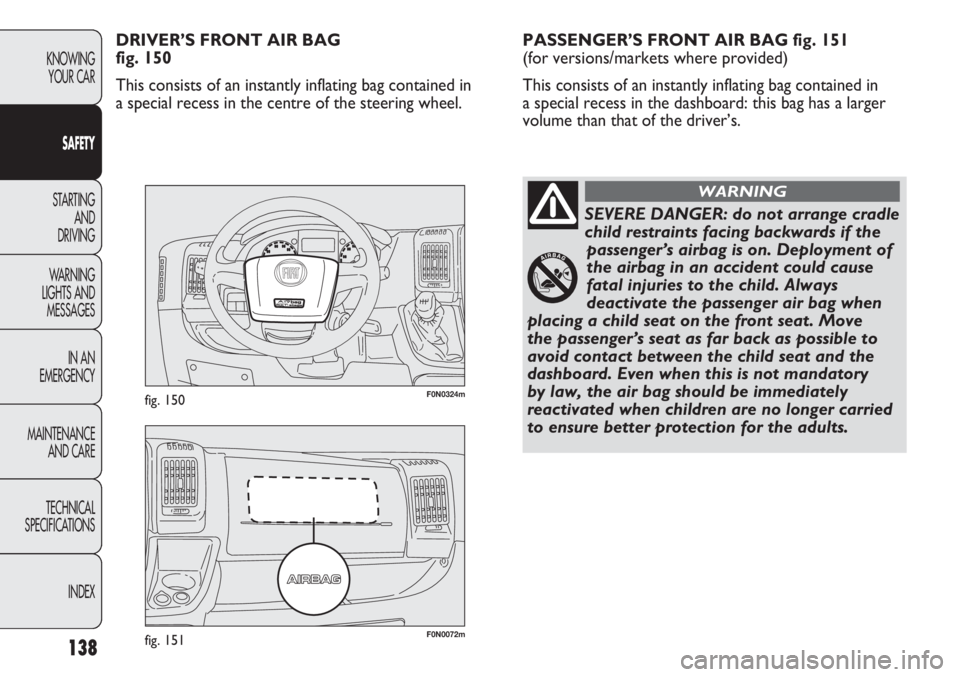
138
KNOWING
YOUR CAR
SAFETY
STARTING
AND
DRIVING
WARNING
LIGHTS AND
MESSAGES
IN AN
EMERGENCY
MAINTENANCE
AND CARE
TECHNICAL
SPECIFICATIONS
INDEX
F0N0072mfig. 151
F0N0324mfig. 150
PASSENGER’S FRONT AIR BAG fig. 151
(for versions/markets where provided)
This consists of an instantly inflating bag contained in
a special recess in the dashboard: this bag has a larger
volume than that of the driver’s. DRIVER’S FRONT AIR BAG
fig. 150
This consists of an instantly inflating bag contained in
a special recess in the centre of the steering wheel.
SEVERE DANGER: do not arrange cradle
child restraints facing backwards if the
passenger’s airbag is on. Deployment of
the airbag in an accident could cause
fatal injuries to the child. Always
deactivate the passenger air bag when
placing a child seat on the front seat. Move
the passenger’s seat as far back as possible to
avoid contact between the child seat and the
dashboard. Even when this is not mandatory
by law, the air bag should be immediately
reactivated when children are no longer carried
to ensure better protection for the adults.
WARNING